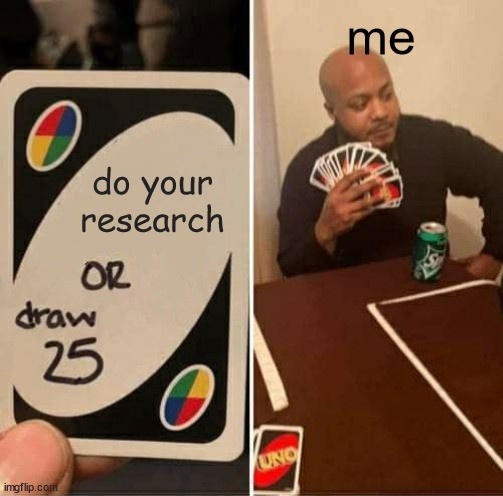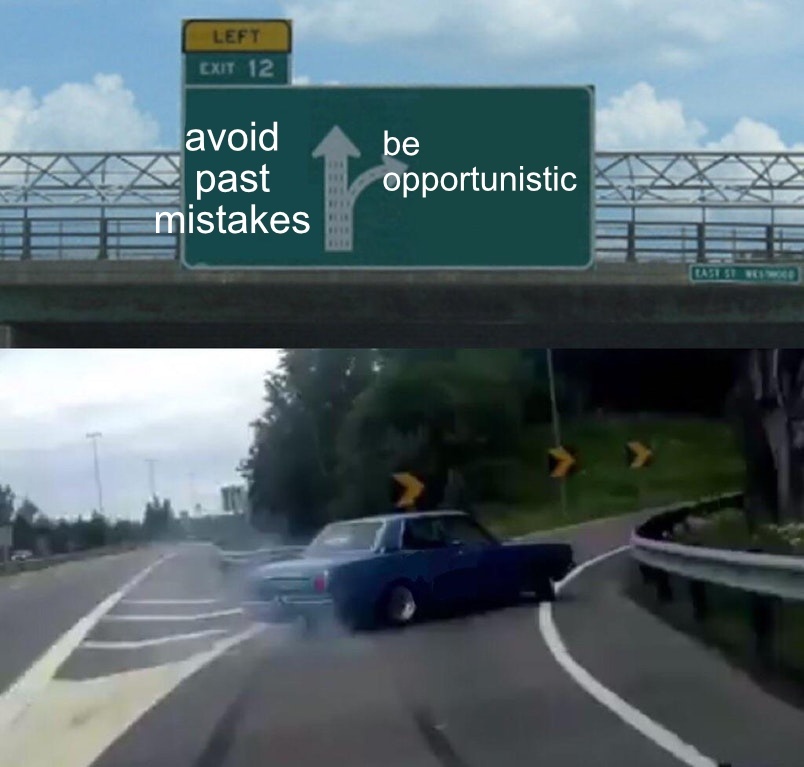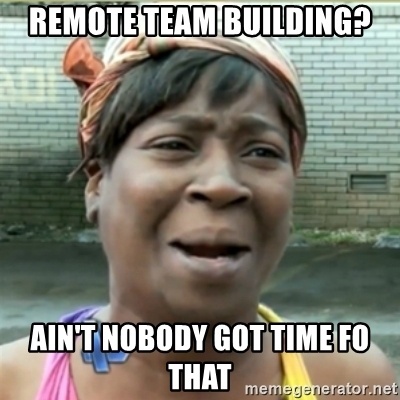Co-Building A New Consulting Arm For 12 Months But Avoiding My Own Dog Food––3 Things I Learned
We’ve been in the process of establishing Innovation Consulting inside of a B2B project organization and despite early successes, there were obvious and avoidable mistakes. Here are 3 of them.
Published October 12, 2021
All the memes in this post are inspired by the great@jobenja. May my meme game one day strive to become as good as his.
Building something new (e.g. a product or a service) from scratch is always a struggle: It needs a structured approach, but even knowing all the lean startup theory and even having made the same mistakes previously, it is sometimes very hard to apply that knowledge to the situation at hand. If you find yourself pursuing success with your product or service in a similar setup, this may help you avoid some of the pitfalls we encountered.
To show you what I learned over the course of the last 12 months, I will explain briefly what we did wrong, condense the learning from those mistakes and in the end will draw up a plan for the near term for each of them.
A Tiny Bit Of Context
When tarent launched its consulting program as a new division, I met my colleague Frederik who experienced a similar mishap in the startup space as mine. And we soon discovered we shared the same ambition: Preventing those mishaps for other innovators in the future. This gradually led to the founding of a new team, mostly driven by him, going by the name of Innovation Consulting.
There was no official start for the team, but it’s now roughly been a year since it became solid enough to be perceived as a distinguishable organizational unit. We had a few early successes with customer projects through a mixed bag of value propositions around the ideas of lean startup, design thinking, fast mvp development and agile––based on the skills the team members brought to the table. Although our order books were more or less filled throughout the year, it didn’t feel like we were nearing a consistent lead funnel or gaining any meaningful insight regarding customer demand and turning that into a repeatable service.
We spent weeks on slide decks and offers simply by discussing among ourselves and getting feedback from the sales department and the management. Granted, we started having a loose process of customer interviews going, but that was about it.
In retrospect, this is a bit shocking, because we usually champion maximizing early learning, especially through primary research in customer projects. In a way, we avoided eating our own dog food. But in retrospect, this was only the most probable outcome of the three main mistakes we made throughout this first year. Let’s dive in.
The 3 Areas Of Mistakes
#1: Lack Of Primary Customer Research
Although we knew exactly how important it is to get early feedback (primarily regarding demand, not so much regarding UX), we didn’t set up a structured approach to do it continuously. Our hope was that simply recruiting interview partners provides enough learning in itself. We didn’t put enough thought into it to even formulate the hypotheses we tried to validate/invalidate through those interviews.
What triggered a rethinking of this process was:
a) the feeling that the current approach seemed to not move us any closer to this vague vision that at least some of us had in their minds.
b) finally catching up on a lot of reading regarding building products, which included The Mom Test, Value Proposition Design, The Lean Startup, The Right It, Running Lean and many more.
How are we dealing with it moving forward?
From now on, we’re trying to dedicate half of our capacity to user research. To bring structure into it, we intend to conduct a series of both quantitative and qualitative experiments where every single one is matched to a hypothesis that’s either consciously based on assumptions or based on prior experiments. For now, we are trying Strategyzer’s Test Cards along with Ash Maurya’s Validation Plan to keep track of those experiments and to keep them aligned with our most pressing questions. So overall, we feel the need to prioritize research as the most important item on our to-do list and do so in a structured manner.
Plus, and I think this may prove to become a very handy tool in customer projects, I decided to hone my experimentation skills and try to develop an intuitive sense of the best ways to validate different kinds of business ideas. For this, I want to spend some of my time outside of my job on experimenting with pretotypes and MVPs for different customer segments and business models.
#2: Distraction
Customer research consumes a lot of time, especially early on. In an organization that’s built upon the business model of billing time it’s tempting to not invest the necessary time for research but generate revenue through customer projects. It is even more tempting to do so in such a highly flexible, cross-functional team that has a wide range of skills (and is quite expensive, too). This conflict of interests has led to parts of the team always being in projects more or less related to innovation consulting (I, for one, have mainly been in software development projects at least 80% of my time). Such distraction has definitely reduced our ability to generate valuable learnings.
How are we dealing with it moving forward?
We feel like we need to be more vocal about the necessary amount of time to build a service that’s an attractive solution to actual problems. Therefore we will clarify our approach and try to convince the organization to give us the time we need.
#3: Team
One thing I’ve underestimated is how important it is to have a clear vision that’s consistent across the team. Even after all this time and even after several projects, there’s still no consensus regarding what’s the actual thing we’re trying to achieve.
On the other hand, maybe also due to distraction, we are just starting to implement tools that generate trust. In the recent past, we even had stretches of weeks that were spent without having a single meeting where all of the team members were present.
The pandemic and being remote definitely was a contributing factor, but overall it still feels like we are just starting out as a team and do not know each other well enough for a 100% psychological safety and the levels of trust and alignment that make a team fly.
How are we dealing with it moving forward?
We are now starting to implement the more bottom up elements of Management 3.0 outlined in Dominik Maximini’s Agile Leadership In Practice by working on core values, vision/mission/strategy alignment, Kudo cards and more. Additionally, we recently set up one non-remote day every week with time blocked for collaborating as a whole team. Instead of having one recurring weekly meeting, we are trying a daily meeting in the hope of increasing both the amount of touch points and flow of discussion.
It’s a tough challenge, though
To put this into a broader perspective, I’ve come to feel like some kinds of businesses are easier to validate than others. For services, especially those that are highly individual like consulting, it is hard to condense a value proposition that fits more than one single client. The interviews we conducted so far were mainly inconclusive because we haven’t been able to acquire many interview partners that matched our anticipated problems (creating successful digital products often fails). This may be because either:
- The problem does not exist,
- there’s no awareness of the problem in the market or
- it’s hard to see in advance if the person carrying a certain job description (innovation manager, product owner, product manager, director) is actually in charge of creating products end-to-end, making the selection of interview partners more of a trial and error process.
So far, either option is possible, but for now I am leaning somewhere between numbers 2 and 3. 2 contains an educational component: it’s hard to strike a balance between those that are aware of the problem and therefore developed the means to overcome it (e.g. leaner development process or soliciting UX feedback are the aspects mentioned) and those that don’t even know that there might be a leaner way to innovation than the old-school waterfall. The former now think they are doing fine since they educated themselves and are ready to take over the world and hence don’t seem to have a problem anymore while the latter don’t even think they have a problem in the first place. Number 3 just makes it incredibly hard to find the right people to talk to, which slows down the learning process.
So maybe on top of not having found the ideal tactics yet, we chose a hard game as well.
The Gist
I described that we’ve been building a new consulting branch dealing with building the right products and preventing their failure in the market. Although some of us knew how important it is to maximize learning in the early stages of a new product or service, we were dumb enough to not thoroughly apply these lessons to this undertaking.
The lack of primary user research in our approach, distraction created through customer projects only partially dedicated to innovation consulting and a delayed teaming process were identified as the main mistakes we made so far. To overcome those, we plan to embrace a more structured approach to learning and prioritize it as well as improving the way we are working together as a team. Plus, I will conduct a series of unrelated pretotyping experiments to become better at it.
Especially for the latter, I will keep you posted!

Timothy Krechel
Innovation Consultant
Subscribe to my product journey.


